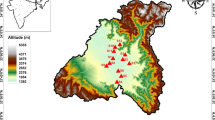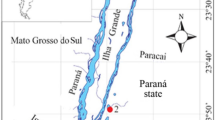Abstract
The number of periphytic algae species in floodplain lakes is strongly related to the flood pulse. Necessarily, algae dynamics are linked to some hydrological attributes such as the frequency, duration and intensity of the pulse. We analysed the variation in richness of the periphytic algae community over eight years (2000–2007). Our aims were (1) to examine periphytic algae richness and its relationship with the pulse regime and (2) to verify temporal changes of this richness in response to frequency, amplitude and intensity attributes. We analysed the potamophase and limnophase periods over the years using the fFITRAS function. Simple regressions were performed to reveal the influence of hydrological attributes on the richness of the periphytic algal community. The hydrological regime presented wide hydrometric-level variation among years, and we verified the predominance of the limnophase periods. Periphytic algae richness was high (371 taxa), presented wide oscillations ranging from 68 to 169 among the years and showed a tight correlation with flood pulse intensity. Our results highlight that the hydrological regime was the main factor structuring the richness pattern of the periphytic algae community in a floodplain environment. Furthermore, the results showed that temporal variations of the periphytic algae richness were related to shifts in flood pulse intensity, suggesting that this attribute is a key factor for periphytic algae communities in the floodplain environment and is important to be considered in studies covering long time series.



Similar content being viewed by others
References
Agostinho AA, Thomaz SM, Minte-Vera CV, Winemiller KO (2000) Biodiversity in the high Paraná river floodplain. In: Gopal B, Junk WJ, Davis JA (eds) Biodiversity in wetlands: assessment, function and conservation. Backhuys Publishers, Leiden, pp 89–118
Algarte VM, Moresco C, Rodrigues L (2006) Algas do perifíton de distintos ambientes na planície de inundação do alto rio Paraná (in Portuguese). Acta Sci Biol Sci 28:243–251
Algarte VM, Siqueira NS, Murakami EA, Rodrigues L (2009) Effects of hydrological regime and connectivity on the interannual variation in taxonomic similarity of periphytic algae. Braz J Biol 69:609–616
Bicudo CEM, Menezes M (2006) Gêneros de algas de águas continentais do Brasil: chave para identificação e descrições. RiMa, São Carlos
Biolo S, Rodrigues L (2013) Comparison of the structure of the periphytic community in distinct substrates from a neotropical floodplain. Int Res J Plant Sci 4:64–75
Brown RL, Jacobs LA, Peet RK (2007) Species richness: small scale. In: Encyclopedia of life sciences. Wiley
Coesel PFM (1996) Biogeography of desmids. Hydrobiologia 336:41–53
Facca C, Sfriso A, Socal G (2002) Changes in abundance and composition of phytoplankton and microphytobenthos due to increased sediment fluxes in the Venice Lagoon, Italy. Estuar Coast Shelf Sci 54:773–792
Fernandes R, Agostinho AA, Ferreira EA, Pavanelli CS, Suzuki HI, Lima DP, Gomes LC (2009) Effects of the hydrological regime on the ichthyofauna of riverine environments of the Upper Paraná River floodplain. Braz J Biol 69:669–680
Ferragut C, Bicudo DC (2010) Periphytic algal community adaptive strategies in N and P enriched experiments in a tropical oligotrophic reservoir. Hydrobiologia 646:295–309
Gotelli NJ, Chao A (2013) Measuring and estimating species richness, species diversity, and biotic similarity from sampling data. In: Levin SA (ed) The encyclopedia of biodiversity, 2nd edn. Elsevier, NewYork
Gotelli NJ, Colwell RK (2001) Quantifying biodiversity: procedures and pitfalls in the measurement and comparison of species richness. Ecol Lett 4:379–391
Hillebrand H (2002) Top-down versus bottom-up control of autotrophic biomass-a meta-analysis on experiments with periphyton. J N Am Benthol Soc (Freshw Sci) 21:349–369
Horner RR, Welch EB, Seeley MR, Jacoby JM (1990) Responses of periphyton to changes in current velocity, suspended sediment and phosphorus concentration. Freshw Biol 24:215–232
Larned ST (2010) A prospectus for periphyton: recent and future ecological research. J N Am Benthol Soc 29:182–206
Leandrini JA, Rodrigues L (2008) Temporal variation of periphyton biomass in semi lotic environments of the upper Paraná River floodplain. Acta Limnol Bras 20:21–28
Magurran AE (1988) Ecological diversity and its measurement. Princeton University Press, New Jersey, 179 p
Murakami EA, Bicudo DC, Rodrigues L (2009) Periphytic algae of the Garças Lake, Upper Paraná River floodplain: comparing the years 1994 and 2004. Braz J Biol 69:459–468
Neiff JJ (1990) Ideas para la interpretación ecológica del Paraná. Interciencia 15:424–441
Neiff JJ (2001) Diversity in some tropical wetland systems of South America. In: Gopal B, Junk WJ, Davis JA (eds) Biodiversity in wetlands: assessment, function and conservation. Backhuys Publishers, Leiden, pp 157–186
Neiff JJ, Neiff M (2003) PULSO 1.1, software para análisis de fenómenos recurrentes. Dirección Nacional de Derecho de Autor no. 236164 (Argentina) Buenos Aires. http://www.neiff.com.ar
Poi De Neiff ASG, Bruquetas De Zozaya IY (1989) Efecto de las crecidas sobre las poblaciones de invertebrados que habitam macrófitas emergentes en las islas del rio Paraná. Rev Hydrobiol Trop 22:13–20
Riegman R, Deboer M, Domis LD (1996) Growth of harmful marine algae in multispecies cultures. J Plankton Res 18:1851–1866
Rodrigues L, Bicudo DC (2001) Similarity among periphyton algal communities in a lentic-lotic gradient of the upper Paraná river floodplain. Braz Rev Bras Bot 24:235–248
Rodrigues L, Bicudo DC (2004) Periphytic algae. In: Thomaz SM, Agostinho AA, Hahn NS (eds) The Upper Paraná river floodplain: physical aspects, ecology and conservation. Backhuys Publishers, Leiden, pp 125–143
Scarsbrook MR (2002) Persistence and stability of lotic invertebrate communities in New Zealand. Freshw Biol 47:417–431
Schneck F, Schwarzbold A, Melo AS (2013) Substrate roughness, fish grazers and mesohabitat type interact to determine algal biomass and sediment accrual in a high-altitude subtropical stream. Hydrobiologia 711:165–173
Souza Filho EE, Stevaux JC (2004) Geology and geomorphology of the Baía-Curutuba-Ivinheima river complex. In: Thomaz SM, Agostinho AA, Hahn NS (eds) The upper Paraná river and its floodplain: physical aspects, ecology and conservation. Backhuys Publishers, Leiden, pp 1–29
Statsoft Incorporation (2005) Statistica for Windows. Tulsa: STATSOFT Inc. http://www.statsoft.com
Thomaz SM, Pagioro TA, Bini LM, Roberto MC, Rocha RRA (2004) Limnological characterization of the aquatic environments and the influence of hydrometric levels. In: Thomaz SM, Agostinho AA, Hahn NS (eds) The upper Paraná river and its floodplain: physical aspects, ecology and conservation. Backhuys Publishers, Leiden, pp 75–102
Thomaz SM, Bini LM, Bozelli RL (2007) Floods increase similarity among aquatic habitats in river-floodplain systems. Hydrobiologia 579:1–13
Tilman D (1993) Species richness of experimental productivity gradients: how important is colonization limitation? Ecology 74:2179–2191
Utermöhl H (1958) Zur Vervollkommnung der quantitative phytoplankton methodic. Mitteilungen Internationale Vereinigung für Theoretische und Angewandte Limnologie 9:1–39
Waide RB, Willig MR, Steiner CF, Mittelbach G, Gough L, Dodson SI et al (1999) The relationship between productivity and species richness. Annu Rev Ecol Syst 30:257–300
Wetzel RG (1983) Periphyton of freshwater ecosystems. Dr. W. Junk Publishers, The Hague
Winter JG, Duthie HC (2000) Epilithic diatoms as indicators of stream total N and P concentration. J N Am Benthol Soc Soc Freshw Sci 19:32–49
Acknowledgements
This study was part of Projeto PELD/CNPq (Pesquisas Ecológicas de Longa Duração/Conselho Nacional de Pesquisas, “A Planície Alagável do Alto Rio Paraná”—Site 6). We thank Research Nucleus in Limnology, Ichthyology and Aquaculture of Maringa State University for the field support and CNPq and Capes for the Masters scholarships granted to Natália S. Siqueira, Vanessa M. Algarte, Daiane T. Ruwer and Nicolli C. Osório and for the productivity fellowship for Liliana Rodrigues.
Author information
Authors and Affiliations
Corresponding author
Rights and permissions
About this article
Cite this article
Algarte, V.M., Siqueira, N.S., Ruwer, D.T. et al. Richness of periphytic algae and its relationship with hydrological attributes. Braz. J. Bot 40, 735–740 (2017). https://doi.org/10.1007/s40415-017-0383-2
Received:
Accepted:
Published:
Issue Date:
DOI: https://doi.org/10.1007/s40415-017-0383-2




